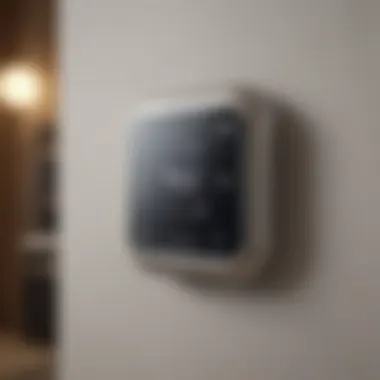Exploring Apple HomeKit Devices: A Comprehensive Guide


Intro
In the rapidly evolving world of home automation, Apple has carved a niche with its HomeKit ecosystem. This platform provides users with the ability to control various devices through a unified interface, enhancing both convenience and security within the home. With its focus on user privacy and seamless integration, HomeKit stands out as a viable option for tech enthusiasts and casual users alike. This guide delves into the intricacies of Apple HomeKit devices, equipping you with the knowledge to better understand how to incorporate this technology into your daily life.
Product Overview
Apple's HomeKit serves as a comprehensive framework for managing smart home devices. The system supports an array of products from different manufacturers, all designed to work together harmoniously. Users can control lights, thermostats, security cameras, and more through the Home app on their iPhones, iPads, or Macs.
Key Features and Specifications
Among the notable features of HomeKit are its automation capabilities, remote access, and security measures. HomeKit devices can be programmed to operate based on user-defined conditions, such as time of day or location. Moreover, the inclusion of Siri as a voice command interface enhances usability, making it easier to control devices hands-free. Encryption protects user data, ensuring that privacy is maintained throughout the smart home experience.
Comparison with Previous Models
HomeKit itself does not have multiple versions, but it continually evolves as Apple integrates updates into iOS and HomePod, enhancing features along the way. The introduction of HomeKit Secure Video is a prime example of Apple's commitment to security, offering users more control over how their video feeds are stored and shared.
Performance and User Experience
The performance of HomeKit devices can be evaluated on various fronts.
Performance Analysis
Speed and responsiveness are critical in smart home environments. HomeKit excels in providing quick response times, particularly for localized commands. Devices typically operate with minimal latency, which is essential for user satisfaction, especially in critical scenarios like security monitoring. Battery life varies by device but is generally efficient, thanks to Apple's focus on optimizing performance.
User Interface and Ease of Use
The Home app presents an intuitive user interface. Users can easily navigate and control their connected devices. The app allows for group management, making it simple to control multiple devices simultaneously. Onboarding new devices is also straightforward, with clear prompts guiding users through the setup process.
User Experience Feedback and Opinions
Feedback from users commonly highlights the smooth interface and effective voice control with Siri. However, some note that device compatibility can be restrictive compared to other smart home ecosystems. Overall, user satisfaction remains high, particularly among Apple loyalists who appreciate the seamless integration across their devices.
Design and Build Quality
Physical attributes of HomeKit compliant devices vary widely across different manufacturers.
Design Elements and Aesthetics
HomeKit devices range from sleek, modern aesthetics to traditional designs, depending on the specific application. Many products aim to blend seamlessly with home decor, which enhances their appeal.
Materials Used in Construction
Materials generally emphasize durability. Plastic, metal, and fabric are common choices, ensuring that devices can withstand everyday wear and tear while maintaining an attractive appearance.
Durability and Build Quality Assessments
Build quality often aligns with the reputation of the manufacturer, with many collaborating closely with Apple to meet specific standards. Reviews often point to the long lifespan of HomeKit devices, reinforcing their initial investment value.
Software and Updates
The operating system underlying HomeKit is a crucial aspect of its functionality.
Operating System Features and Updates
As a built-in feature of iOS, HomeKit benefits from regular updates that introduce new features and enhance security. iOS updates are typically released annually, with minor enhancements in between.
App Compatibility and Availability
The Home app is the primary interface, with countless third-party apps also available for specific device types. Most significant brands offer their own applications designed to work in conjunction with HomeKit, providing versatility in user experiences.
User Customization Options
HomeKit offers a variety of customization options for automation and control. Users can create scenes that combine multiple device settings into one command, such as setting a "Good Night" scene that turns off lights and adjusts the thermostat.
Price and Value Proposition
When considering a smart home system, the price point and available options are crucial for many consumers.


Price Point and Variants Available
HomeKit devices span a broad price range, from budget-friendly options to premium products. The diversity accommodates various budgets and preferences, providing users flexibility.
Value for Money Assessment
In many cases, HomeKit devices offer significant value. The integration with Apple's ecosystem tends to justify initial costs through enhanced functionality and security features.
Comparison with Similar Products in the Market
While comparing with systems like Google Home or Amazon Alexa, HomeKit's focus on privacy and seamless integration within the Apple ecosystem remains distinct. Each platform has its strengths, but HomeKit is particularly appealing for users already invested in Apple products.
In summary, Apple HomeKit devices deliver a compelling combination of interoperability, security, and ease of use, making them a worthy consideration for those looking to enhance their home automation experience.
Preface to Apple HomeKit
In an era where connectivity defines convenience, Apple HomeKit stands out as a notable entry in the realm of smart home technology. This section is crucial to understanding how Apple’s ecosystem brings together diverse devices and systems to build a cohesive home automation experience. With the growing popularity of smart devices, HomeKit serves as a bridge between these technologies, facilitating user control and enhancing home security.
What is Apple HomeKit?
Apple HomeKit is a software framework developed by Apple that allows users to configure, communicate with, and control smart home appliances using Apple devices. It integrates various home automation products under a user-friendly interface, enabling seamless interaction from a single application— the Home app.
HomeKit supports multiple categories of devices, ranging from smart bulbs to security cameras, creating an interconnected system that prioritizes efficiency and user experience. The importance of HomeKit lies not only in its functionality but also in its compatibility with Siri, voicing requests to control multiple devices hands-free. This makes home automation accessible, even to less tech-savvy individuals.
The Evolution of Home Automation
Home automation has evolved dramatically over the past few decades. Initially focused on basic functionalities, it has grown into a sophisticated field where devices communicate and collaborate. Early systems required cumbersome setups involving complex wiring and configurations. With introduction of wireless technology, this process has greatly simplified.
The trend towards smart homes has accelerated with advancements in the Internet of Things (IoT). HomeKit, launched in 2014, accompanied this transformation, reflecting a shift towards user-centric design. Users today expect more from their technology, including intuitive controls and robust security.
"HomeKit represents a pivotal moment in home automation, merging high usability with security and privacy considerations."
As the market changes, more manufacturers adopt the HomeKit protocol, ensuring a wider array of compatible devices. This integration helps users feel empowered in their ability to create customized systems tailored to their needs. Ultimately, Apple's commitment to privacy and security further reinforces the appeal of HomeKit, distinguishing it in a crowded market.
Key Features of Apple HomeKit
Apple HomeKit offers a variety of features that enhance the smart home experience. Understanding these key elements is crucial for anyone considering the use of HomeKit devices in their home. These features are not just technical specifications; they serve practical purposes that improve usability, security, and overall integration of smart devices within the Apple ecosystem.
User-Friendly Interface
The user-friendly interface of Apple HomeKit stands out among other smart home systems. This aspect of HomeKit is designed to make setup and daily interaction straightforward. The Home app on iOS and iPadOS provides a unified control center for all HomeKit-enabled devices. Users can organize their devices by rooms, zones, or even scenes they frequently use. This organization is beneficial for quick access and smoother operation.
Moreover, the interface is intuitive, which allows users of varying technical backgrounds to navigate with ease. The ability to control light brightness, thermostat settings, and security cameras from a single app simplifies the smart home experience significantly. Users can also customize notifications and alerts according to preferences, making it easier to stay informed about home conditions.
Robust Security Protocols
Security is a pressing concern in the realm of smart home technology. Apple HomeKit addresses this with its robust security protocols. These protocols are designed to protect user data and privacy. Data transmitted between HomeKit devices is encrypted, ensuring that unauthorized access is prevented. This encryption is part of Apple’s broader commitment to user privacy.
HomeKit also employs a unique feature called the HomeKit Secure Video. This allows users to store video footage from compatible security cameras securely in iCloud. Users thus maintain control over their data without sacrificing privacy. Apple does not analyze this footage or use it for advertising purposes, a significant consideration for privacy-conscious individuals. Moreover, two-factor authentication is an option, further enhancing security measures for users managing their home automation.
Seamless Device Integration
Seamless device integration is another significant feature of Apple HomeKit. This integration fosters compatibility across numerous devices from multiple manufacturers. Unlike traditional systems that often require specific brands, HomeKit encourages a broader range of compatibility.
For instance, users can integrate smart lights from Philips Hue, thermostats from Ecobee, and security systems from Arlo all within the same ecosystem. This flexibility allows homeowners to create customized smart environments that cater to their specific needs. Users can also utilize Siri for voice commands, simplifying control without the need for manual interaction.
The capacity for automation is further enhanced by the ability to set up "scenes." A scene can adjust multiple devices with a single command—for example, a "Goodnight" scene can set the thermostat, turn off lights, and deactivate the alarm system simultaneously. This level of integration is essential for a cohesive and user-friendly smart home experience.
"The combination of user-friendly interface, robust security protocols, and seamless integration makes Apple HomeKit a strong contender in the smart home market."
Types of Apple HomeKit Devices
Understanding the varied types of Apple HomeKit devices is crucial for anyone looking to create a smart home environment. Each device category plays a distinct role in enhancing convenience, energy efficiency, and security within the home. By analyzing different device types, users can better appreciate how to integrate them effectively into their Apple HomeKit ecosystem. This knowledge fosters informed decision-making, ensuring the selected devices align with personal needs and preferences.
Smart Lighting
Smart lighting is one of the most popular applications of Apple HomeKit. With products like the Philips Hue and LIFX bulbs, users can control their home’s lighting remotely. This includes adjusting brightness, changing colors, and setting schedules through the Home app or via Siri commands. Not only does this enhance convenience, but it also contributes to energy savings by allowing users to turn off lights automatically when not in use.


Smart Thermostats
Smart thermostats significantly optimize home energy consumption. Devices like the Ecobee SmartThermostat and the Nest Learning Thermostat offer advanced features such as learning user habits, adjusting temperature based on occupancy, and remote access to monitor and control heating and cooling. Integrating these devices with Apple HomeKit means users can maintain comfortable living conditions while maximizing energy efficiency.
Home Security Systems
Home security systems are vital for personal safety. Apple HomeKit-compatible security devices, such as the August Smart Lock and Ring Video Doorbell, allow users to monitor their property in real time. These devices offer various functionalities, including live video feeds and secure entry access, providing peace of mind. By using these products with HomeKit, users can create automation routines, enhancing security measures without needing multiple apps or systems.
Smart Plugs and Switches
Smart plugs and switches are essential for controlling traditional devices. With brands like Wemo and Eve, users can turn appliances on or off from anywhere. This is particularly useful for lamps, fans, and other electronics that are not inherently smart. Integrating these devices into the HomeKit ecosystem allows for scheduling and automation, adding versatility in how users manage their electrical devices.
Smart Sensors
Smart sensors, such as security motion sensors and door/window sensors, add another layer of intelligence to home automation. Recognized brands like Aqara provide devices that detect movement, changes in light, or even temperature fluctuations. This information can trigger other automated routines in HomeKit, such as turning on lights when someone enters a room or alerting homeowners if doors are opened unexpectedly. These devices enhance safety and promote a responsive living environment.
By understanding the various types of Apple HomeKit devices and their features, users can curate a personalized smart home experience. Each class of devices contributes individually to create a cohesive automation solution, leading to a more convenient, safe, and energy-efficient home.
Setting Up Apple HomeKit
Setting up Apple HomeKit is a pivotal step in harnessing the full potential of smart home technology. This stage ensures that devices operate together seamlessly, enhancing both convenience and security in home automation. Understanding the setup process can aid users in maximizing the benefits of Apple HomeKit, as well as prepare them for any potential challenges they might encounter.
Requirements for HomeKit Setup
Before diving into the setup process, it is essential to identify the necessary requirements. First and foremost, users must have an iPhone, iPad, or iPod touch running iOS 10 or later. Additionally, a compatible hardware hub is useful for remote access. This can be an Apple TV, iPad, or a HomePod. A steady Wi-Fi connection is also critical, as it allows all devices to communicate effectively. Furthermore, the devices intended for integration must be HomeKit-compatible, which ensures that they can be managed via the Home app.
A strong network connection is a core necessity for reliable communication between HomeKit devices.
Initial Configuration Process
Once the requirements are met, the initial configuration is relatively straightforward. Here is a basic outline of the steps:
- Download the Home App: The Home app comes pre-installed on iOS devices, allowing for easy access to HomeKit settings.
- Add Accessories: Using the Home app, select "Add Accessory". A code will often be required, usually found on the device or packaging.
- Create Rooms and Zones: Organizing devices into specific rooms or zones helps in managing them more effectively. This process includes naming devices and assigning them to their respective locations.
- Configure Settings: Each device may have unique settings or configurations, which should be explored for optimal use.
- Test Each Device: After setup, it is useful to test each device to ensure they respond as expected.
Managing Devices via the Home App
Post-setup, managing devices through the Home app is a user-friendly process. The app serves as a centralized hub for controlling all HomeKit devices. Here are some functionalities available within the app:
- Control Individual Devices: Users can turn devices on or off, adjust brightness in smart lighting, or change temperature settings in smart thermostats.
- Create Scenes: A scene allows multiple devices to function together. For instance, a "Good Night" scene can turn off lights and adjust the thermostat with a single command.
- Set Automations: Automating actions based on user preferences or time schedules provides additional convenience. Users can set devices to operate automatically at specific times or when certain triggers happen.
Managing devices through the Home app ultimately offers a tailored experience that enhances day-to-day living. With just a few taps, users can arrange their home environment with ease.
Advanced HomeKit Features
The advanced features of Apple HomeKit are pivotal for transforming any residence into a smart home. They enhance user experience, streamline device operations, and provide thoughtful integrations that resonate well with tech-savvy individuals. These features not only elevate convenience but also optimize energy use and bolster home security. Understanding these functionalities can help users maximize their HomeKit setup, leveraging the true potential of connected devices.
Automation and Scheduling
Automation is one of the cornerstone advantages of using Apple HomeKit. It enables users to create routines that can run autonomously based on specific conditions or schedules. For example, users can set smart lights to turn on at sunset or have their thermostat adjust when they arrive home from work. This not only simplifies daily tasks but also promotes energy efficiency. Scheduling is exceptionally useful; you can program devices to operate at certain times, ensuring that your home is always responsive to your lifestyle. The user-friendly interface of the Home app allows for easy setup of these automations, making it accessible even for those who may not be particularly tech-savvy.
Geo-fencing Capabilities
Geo-fencing is another innovative feature within HomeKit, providing a defined perimeter around a geographical area. When a user crosses this boundary, it triggers pre-set actions within the home. For instance, as you approach your home, the system can automatically adjust the lights and temperature to create a welcoming environment. This capability integrates seamlessly with user location data, enhancing the smart home experience significantly. It adds a layer of comfort, eliminating the need for manual adjustments. However, users should be aware of privacy implications related to location tracking and how they can manage it.
Integration with Siri
Siri integration is a standout feature of Apple HomeKit. With Siri, users can control their HomeKit devices using voice commands, facilitating hands-free operation. This is particularly useful for people with mobility issues or when users' hands are occupied. Commands like "Hey Siri, turn off the kitchen lights" or "Hey Siri, set the thermostat to 72 degrees" make interactions not only quick but also intuitive.
Moreover, Siri's ability to respond to context-aware commands offers a more intelligent and interactive user experience. Integrating Siri into your HomeKit setup can enhance the convenience of daily routines, placing control directly in the user's voice.
"Advanced HomeKit features such as automation and integration with Siri redefine how we manage our living spaces, enabling seamless connectivity and enhanced user convenience."
In summary, the advanced features of Apple HomeKit deliver unmatched functionality and convenience for smart home users. Automation, geo-fencing, and Siri integration are just a few aspects that exemplify how HomeKit can adapt to individual needs, making everyday life more manageable while prioritizing security and efficiency.
Compatibility Considerations
In the realm of smart home technology, compatibility is crucial for seamless functionality and user satisfaction. Understanding the compatibility of Apple HomeKit devices can significantly enhance the experience of integrating smart products within a household. HomeKit acts as a central hub for various smart devices, ensuring that they work effectively together, thus simplifying the management of these technologies.


HomeKit-Compatible Brands
An expansive range of brands design devices that are compatible with Apple HomeKit. These brands not only ensure compliance with Apple’s strict guidelines but also offer various features that take advantage of HomeKit’s functionalities. Popular HomeKit-compatible brands include:
- Philips Hue for smart lighting solutions, enabling adjustable ambiance and remote control.
- Ecobee for advanced smart thermostats that optimize energy savings through intelligent learning.
- August for smart locks enhancing home security while providing easy access control.
- Logitech for smart cameras that enable monitoring and recording of activities at home.
- Honeywell for smart sensors that track environmental changes.
Choosing devices from these brands ensures a level of reliability, performance, and support that can significantly elevate the automation experience. Each brand brings something unique, and understanding their offerings helps in making informed decisions.
Device Limitations and Considerations
While Apple HomeKit is designed to support a variety of devices, limitations do exist. Some common considerations include:
- Device Limitations: Not all smart devices will have HomeKit support. Users must confirm compatibility before purchase. This can be verified through the HomeKit badge on packaging or the product description online.
- Functionality Variances: Even within compatible devices, features may differ. For instance, while one smart bulb might support color-changing features, another may not, despite both being HomeKit compatible.
- Network Requirements: Devices often require a stable, high-speed internet connection for optimal operation. Poor connectivity can lead to delays in command execution.
Understanding these limitations allows users to align their expectations with the current capabilities of HomeKit devices. In doing so, they can better strategize their smart home setup, ensuring every component works in harmony.
"Knowing which brands and device limitations can affect your HomeKit setup is essential for building a cohesive smart home experience."
HomeKit and Privacy
As we delve into the realm of smart home technology, arguably one of the most pressing issues is privacy. Apple HomeKit stands out not only for its seamless integration and user-friendly interface, but also for its robust approach to privacy concerns. In a world where personal data is a valuable commodity, understanding how HomeKit prioritizes user privacy becomes essential for anyone looking to adopt smart home devices.
Data Protection Measures
Apple implements stringent data protection measures within the HomeKit framework. All the data shared between devices is encrypted using end-to-end encryption. This means that only the user can access their data, making it virtually impossible for unauthorized access. Apple also follows strict protocols for data transmission, ensuring that even metadata is handled securely. The framework is designed so that data processing happens on local devices rather than relying solely on cloud services. This local processing minimizes the risk of data breaches significantly.
In addition, Apple is committed to transparency regarding data collection. Users are informed about what information is being collected and for what purpose. This transparency builds trust and allows users to make informed decisions about their data.
User Control over Data
User control is a fundamental principle of Apple’s approach to privacy in HomeKit. Users have the option to manage their data preferences through the Home app. This includes options to control what data can be shared with third-party applications. If a user wishes to revoke access, they can easily do so, ensuring they retain full authority over their information.
HomeKit also allows users to set permissions for individual devices and users. For example, if a household member no longer needs access to a smart lock or security camera, the primary user can easily alter these settings. This granular control over device access is key to ensuring that only authorized individuals can interact with HomeKit-enabled devices.
"Data privacy isn't just a feature; it's a cornerstone of trust and integrity in today’s digital age."
While the technical framework emphasizes encryption and security, the reality is that user awareness and proactive management of privacy settings play a vital role. By providing clear settings and accessibility, Apple empowers users to take charge of their privacy.
Future of Apple HomeKit Devices
The future of Apple HomeKit devices holds significant implications for both consumers and manufacturers. As smart home technology continues to evolve, understanding the impact of new developments is essential for potential users. Apple HomeKit enhances daily living by allowing more control and automation within the home. With technology advancing at a rapid pace, staying informed about emerging tools and devices is crucial. This section explores notable technologies and anticipated trends that will shape the future of HomeKit.
Emerging Technologies
New technologies are emerging that can take Apple HomeKit to the next level. Some significant innovations are expected that could enhance the functionality and appeal of HomeKit devices:
- Thread Protocol: This low-power mesh networking protocol is increasingly adopted in smart home devices. It improves connectivity between devices, enhances speed, and allows for better battery efficiency. Devices that support Thread can communicate more efficiently, reducing latency when responding to commands.
- Matter Protocol: This is a new standard that unifies smart home technologies. Matter aims to make devices from different manufacturers compatible with one another, streamlining the process for users. HomeKit’s support for Matter would simplify device integrations, making it easier to create a cohesive smart home ecosystem.
- Enhanced AI Capabilities: Artificial intelligence is expected to enhance automation features. With advancements in machine learning, devices can become smarter in adapting to user preferences. HomeKit may leverage AI to analyze user behavior and suggest automations or provide insights on energy efficiency.
The integration of emerging technologies like Thread and Matter will significantly bolster the compatibility and functionality of Apple HomeKit devices, making home automation more seamless.
Predicted Industry Trends
The smart home market is evolving rapidly, and several trends are emerging that can influence HomeKit:
- Growing Market for Home Security: As concerns about home safety increase, manufacturers are likely to focus on advanced security devices. This trend includes better smart locks, surveillance cameras, and alarm systems. Apple HomeKit can position itself at the forefront of this trend by ensuring robust integrations with top security brands.
- Sustainability and Energy Efficiency: Consumers are becoming more eco-conscious. The demand for sustainable smart home devices is likely to grow, driven by features that optimize energy use. HomeKit devices may integrate more environmental sensors, track energy consumption, and suggest actionable insights for reducing waste.
- User Experience Focus: A growing emphasis is placed on user-friendly experiences. This includes better design and interfaces that make devices easier to use. Apple’s commitment to simplicity is likely to remain a strong point, leading to innovations that streamline interactions within the Apple ecosystem.
- Increased Interoperability: As the smart home market matures, the need for interoperable devices becomes essential. This will lead to increased compatibility efforts among manufacturers, and HomeKit will likely play a crucial role in this evolution.
Closure
The culmination of our exploration into Apple HomeKit devices reveals their significant role in transforming home automation. The various categories of devices ranging from smart lighting to security systems combine to create an integrated environment that not only enhances convenience but also increases the security of homes. It is important to recognize how these devices work together within the Apple ecosystem, offering a seamless experience for users.
Summarizing the HomeKit Experience
Apple's HomeKit is more than just a collection of smart devices; it is a robust framework that stands out in the smart home market. Its user-friendly interface allows homeowners to control their devices effortlessly. Additionally, the advanced security protocols ensure that user data and privacy are highly protected. The consistent updates and robust support from Apple mean users can expect longevity and improvement over time.
One notable aspect is the automation capabilities that HomeKit devices offer. Users can set up scenes and routines tailored to their preferences, making everyday tasks effortless. Furthermore, the integration of Siri adds an extra layer of convenience, allowing voice commands to operate various devices with a simple request. This level of control and customization is key to the HomeKit experience and caters to tech enthusiasts looking for sophisticated solutions in their homes.
Final Thoughts on Home Automation Integration
The benefits of integrating Apple HomeKit into everyday life extend beyond mere convenience. It creates a unified network of smart devices that work harmoniously together. For Apple product users, this integration is particularly beneficial because it leverages existing devices and ecosystems, such as iPhones and iPads, making the transition to smart home technology much more manageable.
Moreover, as technology continues to evolve, it is clear that home automation is just beginning to take shape. As we predict trends in this industry, the future of Apple HomeKit devices will likely encompass even more innovative and sophisticated functionalities, paving the way for a more intelligent living experience.
In summary, engaging with Apple HomeKit represents a significant shift towards modern living. It is not merely about adding convenience; it is about enhancing security, ensuring privacy, and experiencing an efficient home filled with possibilities.



